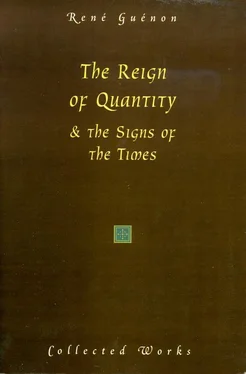Nevertheless, the materia secunda of our world cannot be devoid of all determination, for if it were so it would be inseparable from the materia prima itself in its complete ‘indistinction’; neither can it be a sort of generalized materia secunda , for it must be determined in accordance with the special conditions of this world, in such a way that it can effectively play the part of substance in relation to this world in particular, and not in relation to anything else. The nature of this determination must then be specified, and this is what Saint Thomas Aquinas does when he defines this particular materia secunda as materia signata quantitate ; quality is therefore not inherent in it and is not that which makes it what it is, even if quality is considered only in relation to the sensible order; its place is taken by quantity, which thus really is ex parte materiæ . Quantity is one of the very conditions of existence in the sensible or corporeal world; it is the condition that belongs most exclusively of all to that world; therefore, as might have been expected, the definition of the materia secunda in question cannot concern anything other than this world, but it must concern this world as a whole, for everything that exists in this world is necessarily subject to quantity. The definition given is therefore fully sufficient, and there is no need to attribute to materia secunda , as has been done to modern ‘matter’, properties that can in no way really belong to it. It can be said that quantity, regarded as constituting the substantial side of our world, is as it were its ‘basic’ or fundamental condition: but care must be taken not to go too far and attribute to it an importance of a higher order than is justifiable, and more particularly not to try to extract from it the explanation of this world. The foundation of a building must not be confused with its superstructure: while there is only a foundation there is still no building, although the foundation is indispensable to the building; in the same way, while there is only quantity there is still no sensible manifestation, although sensible manifestation has its very root in quantity. Quantity, considered by itself, is only a necessary ‘presupposition’, but it explains nothing; it is indeed a base, but nothing else, and it must not be forgotten that the base is by definition that which is situated at the lowest level, so that the reduction of quality to quantity is intrinsically nothing but a ‘reduction of the higher to the lower’, and some have very rightly attributed this very character to materialism: to claim to derive the ‘greater’ from the ‘lesser’ is indeed one of the most typical of modern aberrations.
One further question presents itself: we meet with quantity under diverse modes, and in particular as discontinuous quantity, which is nothing but number, [6] The pure idea of number is essentially that of whole number, and it is evident that the sequence of the whole numbers constitutes a discontinuous series; all the extensions that have been applied to this idea, and that have given rise to the notions of fractional numbers and incommensurable numbers, are real alterations, and only in fact represent the efforts that have been made to reduce as far as possible the intervals in the numerical discontinuity, so as to lessen the imperfection inherent in the application of number to continuous magnitudes.
and as continuous quantity, which is principally represented by spatial and temporal magnitudes; among all these modes, which is the one that can most accurately be called pure quantity? This question has its importance, all the more so because Descartes, whose place is at the starting-point of many specifically modern philosophical and scientific conceptions, tried to define matter in terms of extension, and to make his definition the principle of a quantitative physics, which though not yet quite ‘materialism’, was at least ‘mechanism’, and it might be tempting to draw the conclusion that extension, as being directly inherent in matter, represents the fundamental mode of quantity. On the other hand, Saint Thomas Aquinas, when he says that numerus stat ex parte materiae , seems rather to suggest that number constitutes the substantial basis of this world, and therefore that it is number that must properly be looked on as pure quantity; and the attribution of a ‘basic’ character to number is in perfect agreement with the fact that in the Pythagorean doctrine number is taken, by inverse analogy, as the symbol of the essential principles of things. It should be noted too that the ‘matter’ of Descartes is no longer the materia secunda of the scholastics; it is on the other hand an example, perhaps the earliest in point of date, of the modern physicists’ ‘matter’, although Descartes’ notion did not then include all that his successors were gradually to incorporate in it in order to arrive at the most recent theories of the ‘constitution of matter’. There is therefore reason to suspect that there may be some error or confusion in the Cartesian definition of matter, and that some element not of a purely quantitative order must have slipped into it at that stage, perhaps unsuspected by its originator: the nature of his error will be made clear in chapter 4, where we shall see that extension, although it is obviously quantitative in character, like everything else belonging to the sensible world, cannot be regarded as pure quantity. It may also be observed that the theories which go farthest in the direction of a reduction to the quantitative are generally ‘atomistic’ in one way or another, that is to say they introduce discontinuity into their notion of matter in such a way as to bring it into much closer relation to the nature of number than to that of extension; and the very fact that the material from which bodies are formed cannot in any case be conceived otherwise than as extended is never anything but a source of contradictions in all ‘atomism’. Another cause of confusion is the habit that has grown up of considering ‘body’ and ‘matter’ as nearly synonymous; actually, bodies are in no sense materia secunda , which is not met with anywhere in the manifested existences of this world, bodies only proceeding from it as from their substantial principle. But number, like materia secunda , is never perceived directly and in a pure state in the corporeal world, and it is number that must without doubt be considered primarily as constituting the fundamental mode in the domain of quantity; the other modes of quantity are only derived from number, that is to say they are so to speak only quantity by virtue of their participation in number: and this is implicitly recognized whenever it is maintained, as in fact it always is, that everything quantitative must be expressible in terms of number. In these other modes, even when quantity is the predominant element, it always appears as more or less mixed with quality; thus it is that the conceptions of space and of time, despite the efforts of modern mathematicians, can never be exclusively quantitative, unless indeed it be accepted that they must be reduced to entirely empty notions, without contact with any kind of reality; and is not the science of today in actual fact made up to a large extent of such empty notions, purely ‘conventional’ in character and without the least effective significance? This last question must be more fully dealt with, especially so far as it concerns the nature of space, for this aspect of the question is very closely connected with the principles of geometrical symbolism, while at the same time it provides an excellent example of the degeneration that traditional conceptions must undergo in order to become profane conceptions; the procedure will be to examine first of all how the conception of ‘measure’, the very foundation of geometry, can be transposed, in a traditional sense, in such a way as to give it a significance quite other than that which modern scientists attach to it, for they only see in ‘measure’ a means for getting as near as they can to their topsy-turvy ‘ideal’, which seeks to bring about by degrees the reduction of all things to quantity.
Читать дальше











